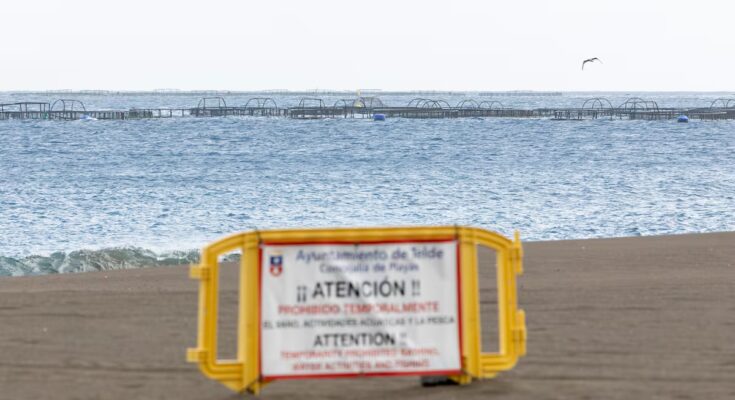This Thursday morning there was almost no sign of the storm Claudia in Mogán, one of the main tourist municipalities of Gran Canaria. The city woke up to a radiant sun. Playa del Cura, one of its main attractions; However, it is almost as deserted as if it were raining. The reason: the remains of decaying organic matter from thousands of dead sea bass on a fish farm in Melenara on the eastern part of the island forced the closure of this and a dozen other beaches on the island. Especially to Mogán, who is threatening to go to court.
The origin of the closure dates back to October 3, when a local fisherman alerted the staff of the company Aquanaria, manager of the fish farm, to the presence of a “strange chemical-looking discharge in the waters near underwater drain No. 222”, a pipe for evacuating municipal waste into the sea, according to the company’s official statement. Since that day, Aquanaria explains that its technical staff has detected a “sharp change in fish behavior and water conditions”. In the following days “an anomalous and progressive mortality was observed, confirming the extraordinary and exogenous nature of the episode”. Thousands of fish have died and the losses are estimated at around 15 million euros, not counting the costs resulting from the management of animal by-products not intended for human consumption (Sandach), transport and waste treatment. Aquanaria is a company of Cantabrian origin dedicated to the breeding of large sea bass for gastronomic use that has been operating in the Canary Islands since 1987. It has 48 hatcheries on the island, where it raises between 40,000 and 50,000 specimens per year.
A spokesperson for the company stressed that the City Council was officially informed for the first time on October 9, the date on which it was asked to take urgent inspection, control and prevention measures, and that it has already submitted 20 official documents via computer archive in which it keeps the Municipality “punctually informed”.
Aquanaria was not the only one affected by these alleged spills. On the 8th, the Ecoaqua University Institute, belonging to the University of Las Palmas de Gran Canaria (ULPGC), reported that it had suffered “an episode of massive fish mortality similar to that which recently occurred in the company’s marine farms” in recent days. The agency calculated that 5% of the total biomass of fish housed in these structures – around 500 specimens – had “lesions at the level of the gills which affected the respiratory capacity, limiting and preventing the exchange of oxygen from the water to the body of the animals”, according to Rafael Ginés Ruiz, coordinator of the aquaculture facilities of the Ecoaqua University Institute in the town of Taliarte (near where the fish farm is located). Aquanaria).
This Monday, the president of the Cabildo of Gran Canaria, Antonio Morales, agreed in a press conference that it was an illegal discharge of hydrogen sulfide gas which, “in theory”, caused the death of fish on the east coast of the island of Gran Canaria and forced the closure of some of its beaches. “Nothing is yet known about its origin and who produced it,” he stressed.
The Telde City Council, however, denies these claims. On the 6th, the Corporation made public the results of some analyzes in which it excluded “the presence of spills of chemical products or anomalous concentrations of heavy metals”. The conclusions obtained “coincide with the analytical records of the previous months, which also showed values within normal parameters and without signs of chemical contamination”.
While the Nature Protection Service (Seprona) of the Civil Guard and the Prosecutor’s Office talk, other theories emerge. Like those of a professor from the University of Las Palmas de Gran Canaria, who assures that the high temperatures recorded in the Canary Islands in recent weeks, together with the accumulation of organic remains and feces, can trigger hydrogen sulfide (H₂S) poisoning capable of killing fish. That is, there were no exogenous reasons.

Be that as it may, the truth is that more than a dozen beaches in the municipality of Telde, as well as those in Mogán and others in Santa Lucía de Tirajana, are still, more than a week later, closed to bathing. Yes, others have reopened, such as Las Burras or San Agustín, in San Bartolomé de Tirajana. The mayor of Mogán, Onalia Bueno, announced on Wednesday that the municipal council is considering taking legal action against the administrations or bodies responsible for the spills: “It cannot be that something that originates in another municipality affects us who are a tourist destination.”
The inhabitants of Telde have also raised their voices in the face of what they consider the inertia of the authorities. Various neighborhood associations and environmental groups in the area have announced a city march this Sunday 16th from the Melenara pier to the nearby town of Salinetas, with the slogan “Sea cages, No!”. Aquanaria, in any case, plans to dismantle these cages in front of the Melenara beach by 2029, the date on which the concession will be transferred.
The closure has affected thousands of residents and tourists enjoying the first stirrings of the high season on the islands. There are those who, however, cannot resist taking a bath despite the prohibitions. Under the midday sun, half a dozen users timidly bathe, ignoring the warnings. Fernando García is one of them: “It smells strange, but I don’t care, I come all week. I hope I don’t regret it.”


